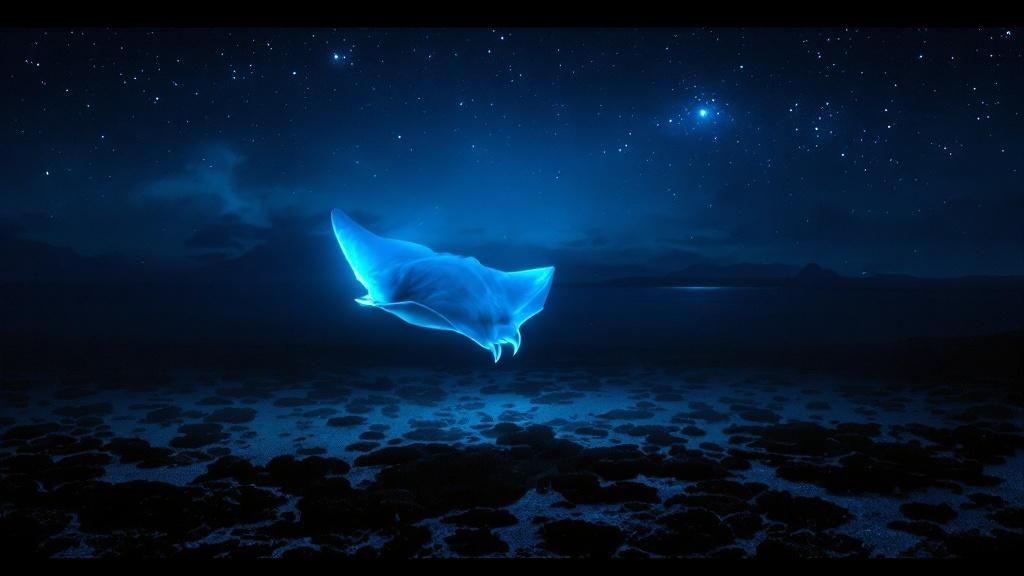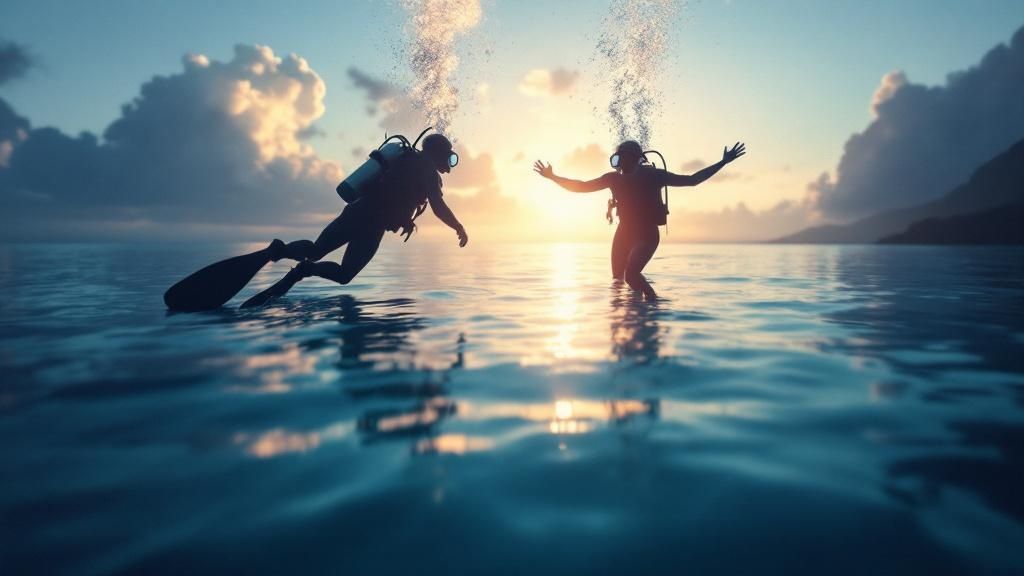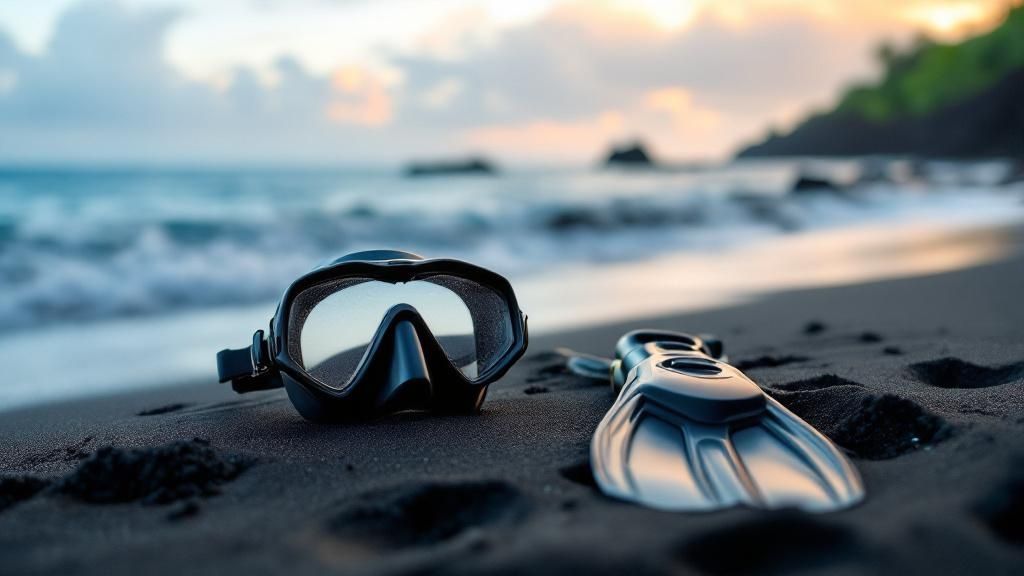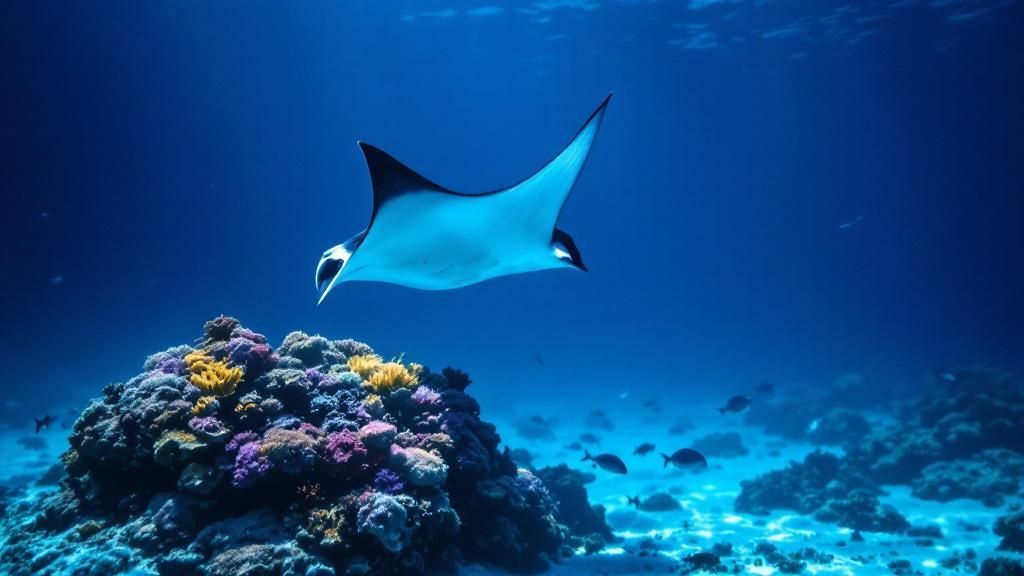The Kona manta ray dive isn't just another dive; it's a world-renowned underwater phenomenon. I've been on a lot of "famous" dives around the globe, and I can tell you, very few live up to the hype like this one. What makes it so special is the sheer reliability of the encounters. This isn't a "maybe we'll see one" situation—it's an almost guaranteed face-to-face meeting with these incredible creatures, making it a true bucket-list trip for anyone who loves the ocean.
What Makes the Kona Manta Dive So Magical?

So, how did Kona become the world's most consistent manta ray hotspot? It's a fascinating mix of natural biology and a bit of human ingenuity. The whole thing started decades ago, and the process is brilliant in its simplicity.
At night, dive boats head out to specific coves and shine powerful lights down into the water. These lights attract massive clouds of plankton, which just so happens to be a manta ray's favorite meal. Over the years, the local manta population has learned that these lights mean an easy, all-you-can-eat buffet.
The result is a spectacular underwater ballet. You settle onto the seafloor (or float on the surface if you're snorkeling) and watch as these gentle giants, some with wingspans over 12 feet, swoop and barrel-roll just inches from your face, scooping up plankton. It's an experience that’s both thrilling and profoundly peaceful.
This unique setup has turned the manta ray dive kona into a cornerstone of Big Island tourism. Every year, an estimated 80,000 people come here specifically for this experience, a testament to its global reputation. You can find more great info on the history and popularity of the dive over at Kona Honu Divers.
Manta Village vs. Manta Heaven
When you start booking your trip, you'll see two primary dive sites mentioned everywhere: Manta Village and Manta Heaven. They both offer amazing experiences with the same population of mantas, but there are key differences that might make one a better fit for you.
- Manta Village (Keauhou Bay): This is the original, classic site. It's tucked into a protected bay, so the water is generally calmer and shallower, usually around 25-35 feet. This makes it the go-to spot for first-time night divers, snorkelers, and anyone who might be a little nervous in the water. The predictability here is off the charts.
- Manta Heaven (Garden Eel Cove): Located further north, closer to the airport, Manta Heaven is a bit deeper and can sometimes have more current. It’s a favorite among seasoned divers looking for a slightly more dynamic environment. On a good night, the number of mantas here can be staggering, presenting some truly epic photo opportunities.
Your choice really hinges on your personal comfort and what you're looking for in the experience.
Insider Tip: Don't get too hung up on which site is "better." Both are incredible. If you're a newer diver or traveling with snorkelers, Manta Village is a fantastic and reliable choice. If you're a confident diver craving a potentially bigger spectacle, Manta Heaven might be your spot.
Manta Village vs Manta Heaven At a Glance
To make the decision even easier, here’s a quick side-by-side look at what to expect from each location.
| Feature | Manta Village (Keauhou Bay) | Manta Heaven (North Kona) |
|---|---|---|
| Location | South of Kona, in a protected bay | North of Kona, near the airport |
| Depth | Shallower (25-35 feet) | Deeper (30-45 feet) |
| Conditions | Typically calm and sheltered | Can have stronger currents and more surge |
| Best For | Beginners, snorkelers, families, first-time night divers | Experienced divers, underwater photographers |
| Crowd Factor | Can be busy, but often feels more organized | Can attract more boats and feel more crowded on popular nights |
| Manta Sightings | Highly reliable and consistent | Often sees a higher number of mantas, but can be less predictable |
Ultimately, you can't go wrong. The Kona manta rays put on an unforgettable show no matter where you see them. The key is to pick the site that best matches your own skill and comfort level for the most enjoyable night possible.
How to Choose the Right Manta Ray Tour

Picking the right company for your manta ray dive in Kona is easily the most critical decision you'll make for this trip. This goes way beyond just comparing prices. The operator you choose will define your entire experience—from your safety in the water to the quality of your encounter and, most importantly, the respect shown to the mantas themselves.
A top-notch tour is built on a foundation of safety. Look for operators who are transparent about their safety protocols, maintain small guest-to-guide ratios, and are staffed by experienced, certified divemasters and boat captains. Don't ever hesitate to ask about their emergency plans or the state of their gear before you hand over your credit card. A good company will be happy to answer.
Beyond safety, a company's commitment to the manta rays' well-being tells you everything you need to know. These magnificent animals are the stars of the show, but they're also part of a fragile ecosystem.
This nightly ballet isn't just a natural wonder; it's a cornerstone of the local economy. Manta ray tourism brings in over $2.5 million to the Kona community each year. That's why managing it responsibly is non-negotiable. Supporting ethical operators ensures this incredible encounter can continue without harming the animals.
Finding an Eco-Conscious Operator
So, how do you find the good guys? Look for tour companies that are recognized as a “Manta Ray Green List Operator” or those that publicly follow its guidelines. These are businesses that have committed to a strict code of conduct designed to protect the mantas and their environment.
This isn't just about feeling good about your choice; it directly translates to a better, more authentic experience for you. Eco-friendly operators live by a few critical rules:
- Hands-Off Policy: They are absolute sticklers about the "no-touching" rule. This is essential for protecting the delicate, protective mucous layer on the mantas' skin.
- Passive Viewing: Their guides will teach you to be a calm, quiet observer. The goal is to let the mantas come to you, which leads to far more natural and breathtaking interactions.
- Responsible Lighting: They know how to use their underwater lights to attract plankton without blinding, confusing, or otherwise harming the rays.
When you choose an operator that puts the animals first, you're doing more than just booking a tour—you're casting a vote for the long-term health of Kona's manta population. For a closer look at what makes this dive so special, check out our article on why you should go on a manta ray dive in Kona.
Snorkeling vs. Scuba Diving: Which is Right for You?
The next big question is how you want to see the show: from the surface as a snorkeler, or from the ocean floor as a scuba diver. There's no "better" option—it all comes down to your comfort in the water and the kind of perspective you're after.
Snorkeling is a fantastic choice for just about anyone, including families with kids, non-swimmers, and those who aren't certified to dive. You'll float on the surface, holding onto a specially designed light board. The view from above is incredible, like watching a squadron of graceful jets soaring up toward you from the deep.
Scuba diving, on the other hand, puts you right in the middle of the action. If you're a certified diver, you'll descend to the sandy bottom, around 30-40 feet, and settle in to watch the show from below. From this vantage point, the mantas glide, barrel roll, and swoop just inches above your head. It’s a truly immersive, 360-degree spectacle that divers never forget.
Preparing for Your Manta Ray Night Dive

A little bit of prep work can be the difference between a good manta ray experience and an absolutely mind-blowing one. It's not just about what you toss in your bag, either. Getting yourself physically and mentally ready is just as important, especially if this is your first time diving after sunset.
Your physical prep should start hours before you even step on the boat. To keep potential seasickness from ruining your night, steer clear of heavy, greasy meals and too much alcohol on dive day. A light meal and plenty of water is the way to go. If you know you're prone to motion sickness, pop a non-drowsy Dramamine or slip on some motion sickness bands well before the boat leaves the dock. Trust me on this one.
Packing smart also makes a world of difference. The air in Hawaii is warm, but after you've been in the ocean at night, that boat ride back to the harbor can feel surprisingly cold.
What to Bring on the Boat
You don't need a massive duffel bag, just a small dry bag with a few key items to keep you comfortable.
- Something Warm: A hoodie or a simple windbreaker is non-negotiable for the ride home. You'll be glad you have it.
- A Towel: Don't assume the boat will have them. They usually don't. Bring your own.
- Reef-Safe Sunscreen: If you're on one of the earlier sunset tours, you'll want to apply this beforehand. It protects your skin and the fragile coral ecosystem.
- Reusable Water Bottle: Staying hydrated is always a good idea, plus it cuts down on plastic waste.
Pay attention during the pre-dive briefing. I can't stress this enough. Your guides will walk you through all the critical safety info, how to behave around the mantas (a big one!), and the specific hand signals you'll use in the dark. This isn't just fluff—it's for your safety and the well-being of the rays.
Understanding Night Dive Hand Signals
Communicating underwater at night is a whole different ballgame. It's all done with your dive light. While your guide will cover the basics, getting a little familiar with them ahead of time will make you feel much more comfortable in the water. For a good overview, check out this guide to common PADI night diving hand signals.
You’ll use your light to "paint" signals on your own hand or to get your buddy's attention. For example, making a big circle with your light beam on the seafloor means "OK." Getting these simple signals down ensures you can easily check in with your guide and dive partner once you descend into the incredible world of the mantas.
What the Manta Ray Encounter Is Really Like
The boat ride out is buzzing with excitement, but the real magic starts the second you slide into the dark, surprisingly warm waters of the Pacific. All the topside noise vanishes. It’s replaced by the gentle hum of the ocean and the sound of your own breathing through the regulator—a shift that instantly pulls you into the present moment.
As a diver, you'll follow your guide down to the sandy bottom, usually somewhere between 30 to 40 feet. Once there, you’ll find a spot in a semi-circle around a collection of powerful lights planted on the seafloor. We call this the underwater "campfire," and it’s the stage for the show you’re about to see. Your only job? Get comfortable, find your neutral buoyancy, and hold perfectly still.
The Manta Ballet Begins
At first, all you see is the deep blue, pierced by beams of light cutting through the darkness. Tiny fish and other critters might flit in and out of view. And then… a shadow emerges from the blackness. A graceful, silent giant glides into the light, larger than you could have ever imagined. The first time you see a manta materialize like that, it's a moment that will stick with you forever.
Soon, another joins, then another, drawn in by the massive clouds of plankton that have gathered in the lights. What follows is nothing short of a ballet. The mantas perform effortless, acrobatic loops and barrel rolls to feed.
- Graceful Swoops: They soar up from below, mouths wide open to filter the plankton from the water.
- Barrel Rolls: You’ll often see them perform full barrel rolls just inches above your head. It’s a jaw-dropping display of agility.
- Close Fly-Bys: They glide so close you feel like you could reach out and touch them—but you absolutely must not.
This whole encounter is about passive observation. Your stillness is the key to making the magic happen. The mantas aren't spooked by calm, stationary divers, which allows them to get incredibly close and go about their feeding, completely undisturbed by your presence.
Why Kona Is a World-Class Experience
The consistency and quality of the Kona manta ray dive are truly something special. I've been on countless dives here, and it rarely disappoints. Research data backs this up, showing that Kona's dive sites average around 20 manta ray sightings per night—that's often double what you might see in other global hotspots. When you combine that with water visibility that frequently tops 100 feet, you have the perfect recipe for a mind-blowing show.
This reliability means your odds of having an unforgettable, life-changing encounter are incredibly high. For so many people, this isn't just another dive; it's a genuine connection with one of the ocean's most magnificent creatures. Whether you're scuba diving on the seafloor or snorkeling at the surface, the experience is universally awe-inspiring.
If you're still weighing your options, our guide on the manta ray night dive in Kailua-Kona can help you figure out the best fit. But the takeaway from every trip is the same: relax, be present, and let these gentle giants put on their nightly spectacle.
Insider Tips for a Flawless Manta Experience
https://www.youtube.com/embed/rLNwQqPo2m4
Booking a spot on Kona's world-famous manta ray dive is just the first step. To really make it a core memory, you need the inside scoop—the little things that can elevate a great trip into a truly perfect one. These are the details you won't find in a tour brochure, but they make all the difference once you're in the water.
A question I hear all the time is, "When's the best time to go?" While you can see mantas here any day of the year, I always recommend aiming for late spring through early fall (April to October). The seas are typically calmer then, and the visibility is often at its peak. This just makes for a more comfortable and visually stunning experience, especially if it's your first time night diving or snorkeling.
Debunking Common Manta Myths
Let's clear something up right away: the moon phase myth. You'll hear people say that a new moon is better because the darker sky makes the dive lights more attractive to plankton, which in turn draws in the mantas. In my experience, and in the logs of nearly every operator in Kona, the effect is so small it’s not even worth planning around.
Honestly, don't sweat it. We see incredible manta shows all month long. Your experience will be shaped far more by the crew's skill and the specific ocean conditions that evening than by how much of the moon is visible.
The single best piece of advice any seasoned guide will give you? Relax and be present. It's so easy to get caught up trying to get the perfect photo, but the most profound moments happen when you simply float and watch the silent, graceful ballet unfold around you.
Capturing the Moment Respectfully
Of course, you’ll want photos or videos to remember the night. But there's a right way and a wrong way to do it—a way that respects the animals and doesn't ruin the moment for you or others. First and foremost, forget the flash. It's strictly forbidden because it can startle and disorient the mantas.
Instead, here’s how the pros get those amazing shots:
- Use the "Stage" Lighting: The powerful lights placed on the seafloor or attached to the snorkel board are your only light source. Let them do the work! Position yourself so the mantas are illuminated from below as they glide overhead.
- Keep it Steady: It's dark down there, so shaky hands will ruin your footage. Brace your camera against your body or, if you're diving, steady yourself on the sandy bottom to get a stable shot.
- Shoot Up: The most iconic and breathtaking shots are taken from below, looking up. This angle captures the manta’s massive wingspan and bright white belly against the dark ocean, highlighting their sheer grace and size.
Your connection to the experience doesn't have to stop when you get out of the water. Many of Kona's resident mantas have been identified, named, and cataloged. You can actually go online to manta identification databases and try to find the specific rays you met! It’s an amazing way to feel like a citizen scientist and deepen your appreciation for these gentle giants. To get a full picture of this incredible adventure, check out this guide to the manta ray night dive on the Big Island.
Finally, a quick word on expectations. While the success rate for seeing mantas in Kona is incredibly high—over 90%—this is still the wild ocean. The number of mantas can range from a couple of curious visitors to more than a dozen feasting in a frenzy. Go into it with a sense of wonder, not a checklist, and you are guaranteed to leave with a memory that will last a lifetime.
Answering Your Kona Manta Ray Dive Questions

It’s completely normal to have questions before booking a trip like this, even with all the hype. In fact, asking the right questions is the first step toward having an incredible and worry-free experience.
Let's walk through some of the most common concerns I hear from people planning their own manta adventure. Getting these cleared up will help you book with confidence and focus on the magic of the moment.
Is the Manta Ray Dive Safe for Beginners?
Yes, absolutely. This is one of the most beginner-friendly night dives on the planet. I've seen countless first-time night divers feel perfectly at ease because the whole operation is so controlled and professional.
Every trip is guided by certified divemasters and instructors. Their entire job is to keep you safe and comfortable. The dive itself happens in calm, shallow water—we're talking 30-40 feet deep, maximum. You're not navigating caves or wrecks; you simply find a spot on the sandy bottom, relax, and watch the show unfold above you.
Not a certified diver? No problem. The snorkeling option is just as spectacular. You'll hold onto a specially designed light board at the surface, which gives you an amazing top-down view of the mantas as they gracefully barrel roll right below you.
What Happens if No Mantas Show Up?
This is a great question and a totally valid concern. The good news is that it's extremely rare. The Kona manta dive has an astonishingly high success rate, consistently over 90%. The mantas have learned over many, many years that the lights from the dive groups mean an easy meal.
But, they are wild animals, so nothing is ever 100% guaranteed. On the off chance the mantas decide to dine elsewhere for the evening, pretty much every reputable operator has a "manta guarantee."
What this usually means for you:
- You get to go again on another night for free.
- This is exactly why I always tell people to book their manta trip for the beginning of their vacation. That way, you have plenty of time to reschedule if you happen to hit that unlucky 10% night.
Can I Touch the Manta Rays?
The answer here is a simple and emphatic no. This is the number one rule, and it's not just about being respectful—it's critical for the mantas' health.
Manta rays have a protective mucous layer covering their skin. Think of it as their immune system. When a human touches them, our oils and friction strip away this vital coating, leaving them exposed to harmful bacteria and infections.
By simply observing and not touching, you're doing your part to protect these gentle giants. It ensures the Kona mantas stay healthy and that this incredible encounter remains a sustainable, ethical experience for generations to come.
Ready to see the underwater ballet for yourself? Kona Honu Divers runs fantastic, eco-conscious tours led by experts. Book your unforgettable adventure today!
